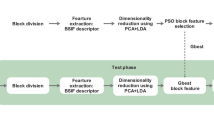Abstract
Face recognition is one of the most important and widely applicable research problems in the subject area of machine learning and computer vision. Extraction of features, local or holistic, is the fundamental step and subspace method has been a natural choice for facial feature extraction. Among these, methods like PCA, ICA, LDA aim to reduce the dimension of the data while retaining the statistical separation property between distinct classes. Unlike the traditional ICA, in which the whole face image is stretched into a vector before calculating the independent components (ICs), Block ICA (B-ICA) partitions the facial images into blocks and takes the block as the training vector. Since the dimensionality of the training vector in B-ICA is much smaller than that in traditional ICA, reduction in face recognition error is expected. The objective of ICA is to find a separation matrix and it is achieved by a process of optimization, such as maximization of non-Gaussianity, maximum likelihood estimation, and minimization of mutual information. We observe here that the gradient-based learning can be efficiently and effectively achieved by the application of swarm-based optimization. We propose here the application of our Gradient-based Swarm Optimization method for Block ICA, where gradient information is combined with conventional swarm search to optimize the contrast function. We compare our method with B-ICA on three benchmark image data sets and show that our method achieved a better recognition rate compared to B-ICA in different block sizes with 70%, 80% and 90% data used for training the model.

Similar content being viewed by others
References
Bao LN, Le D-N, Van Chung L, Nguyen GN (2016) Performance evaluation of video-based face recognition approaches for online video contextual advertisement user-oriented system. In: Satapathy SC, Mandal JK, Udgata SK, Bhateja V (eds) Information systems design and intelligent applications. Springer, New Delhi, pp 287–295
Bartlett MS, Movellan JR, Sejnowski TJ (2002) Face recognition by independent component analysis. IEEE Transactions on Neural Networks/a Publication of the IEEE Neural Networks Council 13(6):1450
Belhumeur PN, Hespanha JP, Kriegman DJ (1997) Eigenfaces vs. fisherfaces: Recognition using class specific linear projection. IEEE Trans Pattern Anal Mach Intell 19(7):711–720
Castella M, Moreau E (2010) A new method for kurtosis maximization and source separation. In: 2010 IEEE international conference on acoustics speech and signal processing (ICASSP). IEEE, pp 2670–2673
Castella M, Moreau E (2012) New kurtosis optimization schemes for miso equalization. IEEE Trans Signal Process 60(3):1319–1330
Choi H, Zhu E, Bangash A, Miller RJ (2019) Vise: vehicle image search engine with traffic camera. Proceedings of the VLDB Endowment 12(12):1842–1845
Chu Y, Zhao L, Ahmad T (2019) Multiple feature subspaces analysis for single sample per person face recognition. Vis Comput 35(2):239–256
DeVault D, Artstein R, Benn G, Dey T, Fast E, Gainer A, Georgila K, Gratch J, Hartholt A, Lhommet M et al (2014) Simsensei kiosk: A virtual human interviewer for healthcare decision support. In: Proceedings of the 2014 international conference on autonomous agents and multi-agent systems, AAMAS ’14, pp 1061–1068, Richland, SC
Kawamoto M, Kohno K, Inouye Y (2007) Eigenvector algorithms incorporated with reference systems for solving blind deconvolution of mimo-iir linear systems. IEEE Signal Process Lett 14(12):996–999
De la Torre M, Granger E, Radtke PVW, Sabourin R, Gorodnichy DO (2015) Partially-supervised learning from facial trajectories for face recognition in video surveillance. Information Fusion 24:31–53
Kumar PM, Gandhi U, Varatharajan R, Manogaran G, Jidhesh R, Vadivel T (2019) Intelligent face recognition and navigation system using neural learning for smart security in internet of things. Clust Comput 22(4):7733–7744
Liu C (2004) Enhanced independent component analysis and its application to content based face image retrieval. IEEE Trans Sys Man Cybern Part B (Cybernetics) 34(2):1117–1127
Parmar DN, Mehta BB (2014) Face recognition methods & applications.arXiv:1403.0485
Pati R, Kumar V, Pujari AK (2019) Gradient-based swarm optimization for ica. In: Pati B, Panigrahi CR, Misra S, Pujari AK, Bakshi S (eds) Progress in advanced computing and intelligent engineering. Springer, pp 225–235
Simon C, Loubaton P, Vignat C, Jutten C, d’Urso G (1999) Separation of a class of convolutive mixtures: a contrast function approach. In: 1999 IEEE international conference on acoustics, speech, and signal processing, 1999. Proceedings, vol 3. IEEE, pp 1429–1432
Tugnait JK (1997) Identification and deconvolution of multichannel linear non-gaussian processes using higher order statistics and inverse filter criteria. IEEE Trans Signal Process 45(3):658–672
Turk M, Pentland A (1991) Eigenfaces for recognition. J Cogn Neurosci 3(1):71–86
Yang J, Zhang D, Frangi AF, Yang J (2004) Two-dimensional pca: a new approach to appearance-based face representation and recognition. IEEE Trans Pattern Anal Mach Intell 26(1):131–137
Yang J, Zhang D, Yong X, Yang J (2005) Two-dimensional discriminant transform for face recognition. Pattern Recognit 38(7):1125–1129
Ye J, Janardan R, Li Q (2005) Two-dimensional linear discriminant analysis. In: Advances in neural information processing systems, pp 1569–1576
Zhang L, Gao Q, Zhang D (2007) Block independent component analysis for face recognition. In: 14th international conference on image analysis and processing, 2007. ICIAP 2007. IEEE, pp 217–222
Zhang Y, McCullough C, Sullins JR, Ross CR (2010) Hand-drawn face sketch recognition by humans and a pca-based algorithm for forensic applications. IEEE Trans Syst Man Cybern - Part A: Syst Hum 40(3):475–485
Acknowledgements
We thank the anonymous reviewers whose comments/suggestions helped to improve and clarify this manuscript to a large extent.
Author information
Authors and Affiliations
Corresponding author
Additional information
Publisher’s note
Springer Nature remains neutral with regard to jurisdictional claims in published maps and institutional affiliations.
Rights and permissions
About this article
Cite this article
Pati, R., Pujari, A.K. & Gahan, P. Face recognition using particle swarm optimization based block ICA. Multimed Tools Appl 80, 35685–35695 (2021). https://doi.org/10.1007/s11042-021-10792-5
Received:
Revised:
Accepted:
Published:
Issue Date:
DOI: https://doi.org/10.1007/s11042-021-10792-5




